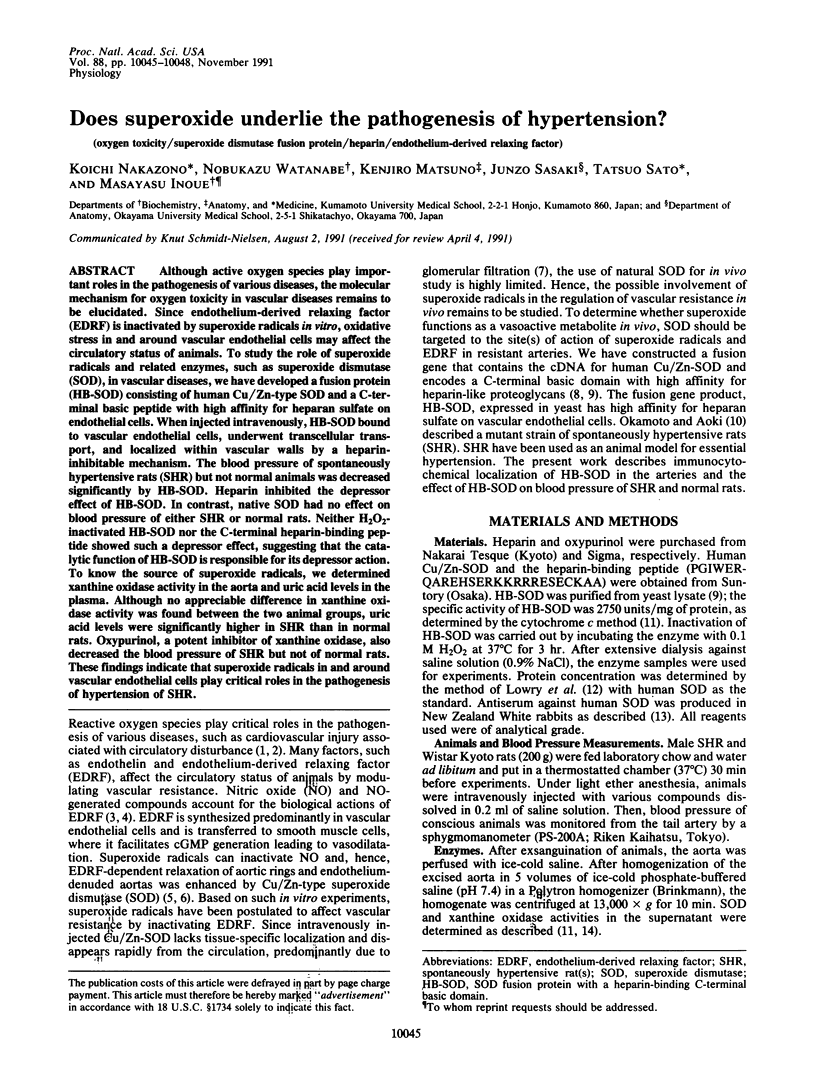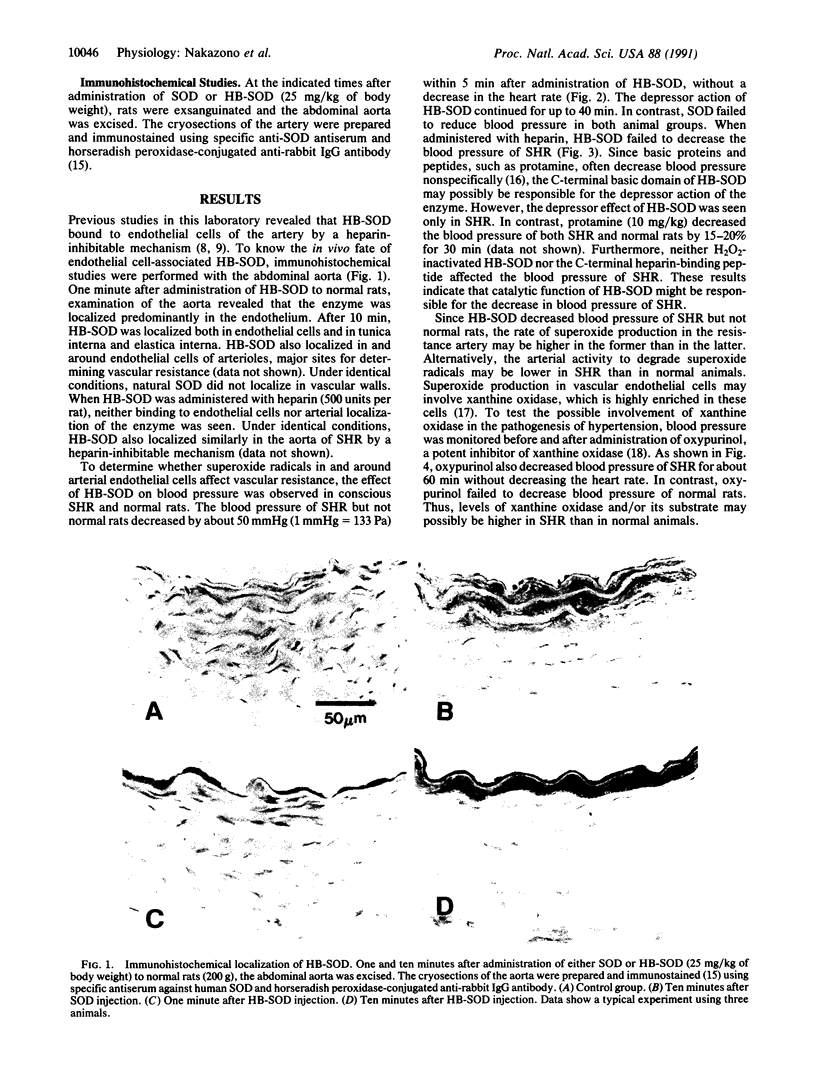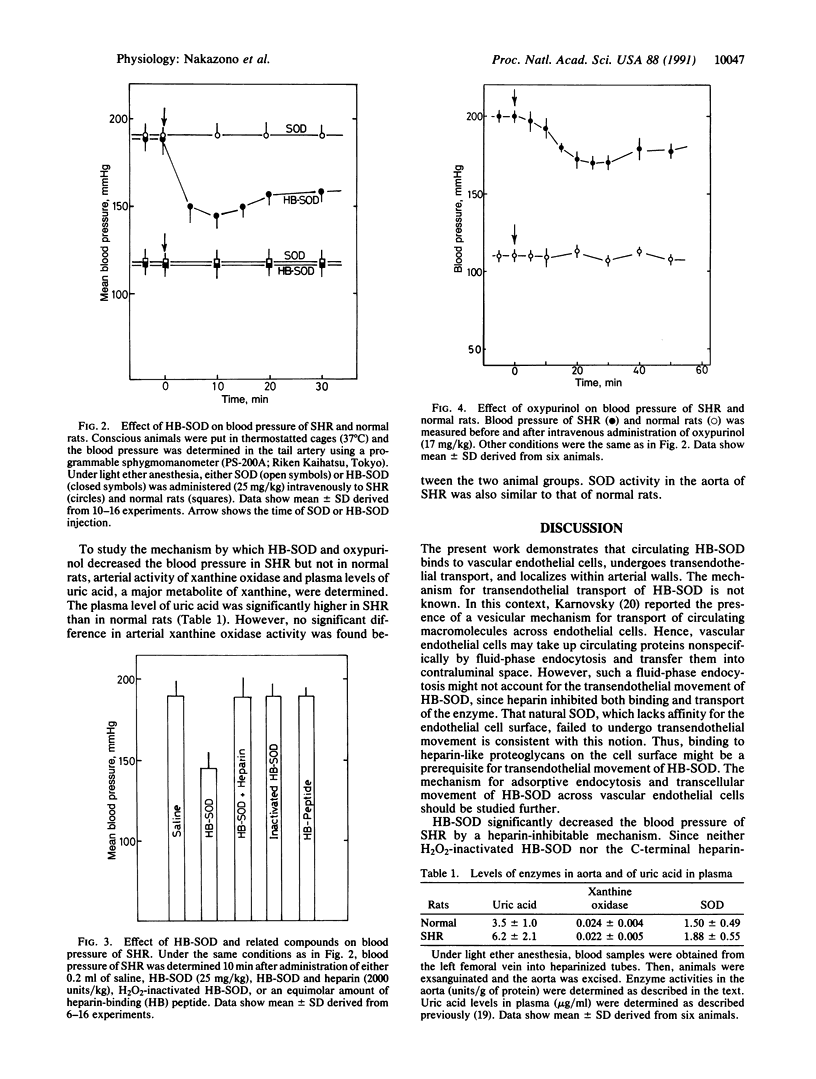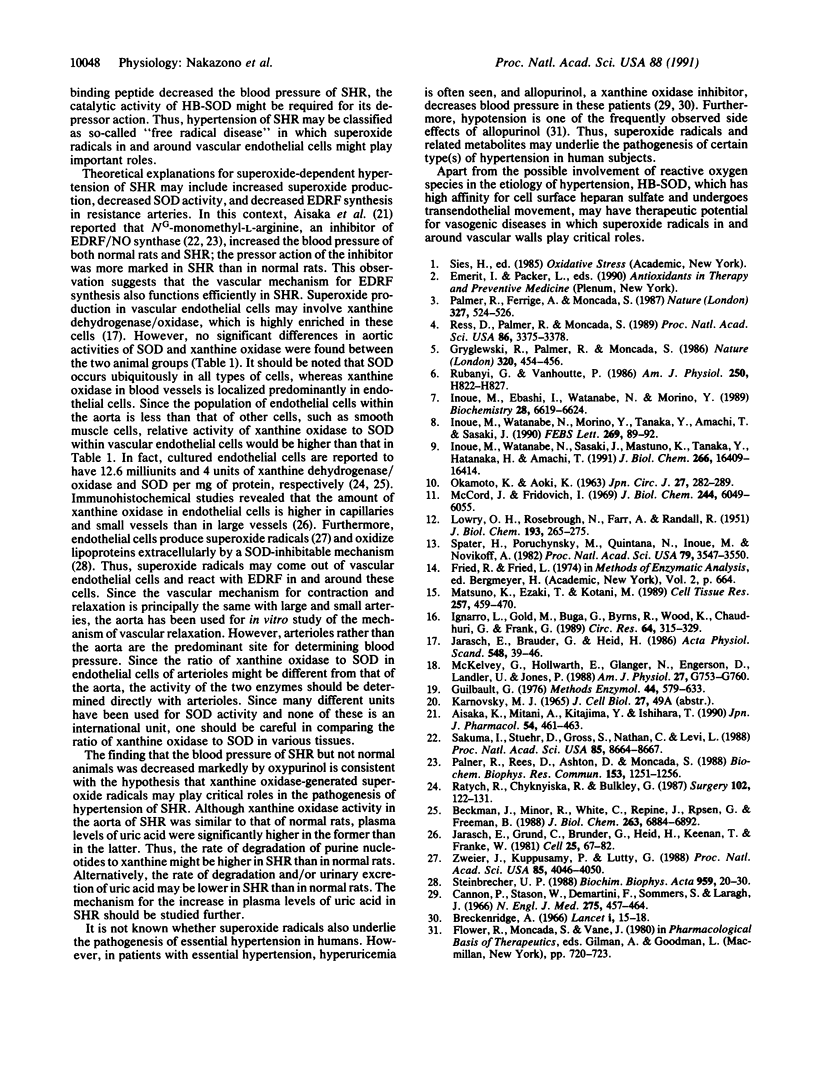Abstract
Although active oxygen species play important roles in the pathogenesis of various diseases, the molecular mechanism for oxygen toxicity in vascular diseases remains to be elucidated. Since endothelium-derived relaxing factor (EDRF) is inactivated by superoxide radicals in vitro, oxidative stress in and around vascular endothelial cells may affect the circulatory status of animals. To study the role of superoxide radicals and related enzymes, such as superoxide dismutase (SOD), in vascular diseases, we have developed a fusion protein (HB-SOD) consisting of human Cu/Zn-type SOD and a C-terminal basic peptide with high affinity for heparan sulfate on endothelial cells. When injected intravenously, HB-SOD bound to vascular endothelial cells, underwent transcellular transport, and localized within vascular walls by a heparin-inhibitable mechanism. The blood pressure of spontaneously hypertensive rats (SHR) but not normal animals was decreased significantly by HB-SOD. Heparin inhibited the depressor effect of HB-SOD. In contrast, native SOD had no effect on blood pressure of either SHR or normal rats. Neither H2O2-inactivated HB-SOD nor the C-terminal heparin-binding peptide showed such a depressor effect, suggesting that the catalytic function of HB-SOD is responsible for its depressor action. To know the source of superoxide radicals, we determined xanthine oxidase activity in the aorta and uric acid levels in the plasma. Although no appreciable difference in xanthine oxidase activity was found between the two animal groups, uric acid levels were significantly higher in SHR than in normal rats. Oxypurinol, a potent inhibitor of xanthine oxidase, also decreased the blood pressure of SHR but not of normal rats. These findings indicate that superoxide radicals in and around vascular endothelial cells play critical roles in the pathogenesis of hypertension of SHR.
Full text
PDF



Images in this article
Selected References
These references are in PubMed. This may not be the complete list of references from this article.
- Aisaka K., Mitani A., Kitajima Y., Ishihara T. Pressor effect of NG-monomethyl-L-arginine in SHRSP. Jpn J Pharmacol. 1990 Dec;54(4):461–463. doi: 10.1254/jjp.54.461. [DOI] [PubMed] [Google Scholar]
- Beckman J. S., Minor R. L., Jr, White C. W., Repine J. E., Rosen G. M., Freeman B. A. Superoxide dismutase and catalase conjugated to polyethylene glycol increases endothelial enzyme activity and oxidant resistance. J Biol Chem. 1988 May 15;263(14):6884–6892. [PubMed] [Google Scholar]
- Breckenridge A. Hypertension and hyperuricaemia. Lancet. 1966 Jan 1;1(7427):15–18. doi: 10.1016/s0140-6736(66)90005-5. [DOI] [PubMed] [Google Scholar]
- Cannon P. J., Stason W. B., Demartini F. E., Sommers S. C., Laragh J. H. Hyperuricemia in primary and renal hypertension. N Engl J Med. 1966 Sep 1;275(9):457–464. doi: 10.1056/NEJM196609012750902. [DOI] [PubMed] [Google Scholar]
- Gryglewski R. J., Palmer R. M., Moncada S. Superoxide anion is involved in the breakdown of endothelium-derived vascular relaxing factor. Nature. 1986 Apr 3;320(6061):454–456. doi: 10.1038/320454a0. [DOI] [PubMed] [Google Scholar]
- Guilbault G. G. Enzyme electrodes and solid surface fluorescence methods. Methods Enzymol. 1976;44:579–633. doi: 10.1016/s0076-6879(76)44043-0. [DOI] [PubMed] [Google Scholar]
- Ignarro L. J., Gold M. E., Buga G. M., Byrns R. E., Wood K. S., Chaudhuri G., Frank G. Basic polyamino acids rich in arginine, lysine, or ornithine cause both enhancement of and refractoriness to formation of endothelium-derived nitric oxide in pulmonary artery and vein. Circ Res. 1989 Feb;64(2):315–329. doi: 10.1161/01.res.64.2.315. [DOI] [PubMed] [Google Scholar]
- Inoue M., Ebashi I., Watanabe N., Morino Y. Synthesis of a superoxide dismutase derivative that circulates bound to albumin and accumulates in tissues whose pH is decreased. Biochemistry. 1989 Aug 8;28(16):6619–6624. doi: 10.1021/bi00442a013. [DOI] [PubMed] [Google Scholar]
- Inoue M., Watanabe N., Matsuno K., Sasaki J., Tanaka Y., Hatanaka H., Amachi T. Expression of a hybrid Cu/Zn-type superoxide dismutase which has high affinity for heparin-like proteoglycans on vascular endothelial cells. J Biol Chem. 1991 Sep 5;266(25):16409–16414. [PubMed] [Google Scholar]
- Inoue M., Watanabe N., Morino Y., Tanaka Y., Amachi T., Sasaki J. Inhibition of oxygen toxicity by targeting superoxide dismutase to endothelial cell surface. FEBS Lett. 1990 Aug 20;269(1):89–92. doi: 10.1016/0014-5793(90)81126-9. [DOI] [PubMed] [Google Scholar]
- Jarasch E. D., Bruder G., Heid H. W. Significance of xanthine oxidase in capillary endothelial cells. Acta Physiol Scand Suppl. 1986;548:39–46. [PubMed] [Google Scholar]
- Jarasch E. D., Grund C., Bruder G., Heid H. W., Keenan T. W., Franke W. W. Localization of xanthine oxidase in mammary-gland epithelium and capillary endothelium. Cell. 1981 Jul;25(1):67–82. doi: 10.1016/0092-8674(81)90232-4. [DOI] [PubMed] [Google Scholar]
- LOWRY O. H., ROSEBROUGH N. J., FARR A. L., RANDALL R. J. Protein measurement with the Folin phenol reagent. J Biol Chem. 1951 Nov;193(1):265–275. [PubMed] [Google Scholar]
- Matsuno K., Ezaki T., Kotani M. Splenic outer periarterial lymphoid sheath (PALS): an immunoproliferative microenvironment constituted by antigen-laden marginal metallophils and ED2-positive macrophages in the rat. Cell Tissue Res. 1989 Sep;257(3):459–470. doi: 10.1007/BF00221456. [DOI] [PubMed] [Google Scholar]
- McCord J. M., Fridovich I. Superoxide dismutase. An enzymic function for erythrocuprein (hemocuprein). J Biol Chem. 1969 Nov 25;244(22):6049–6055. [PubMed] [Google Scholar]
- McKelvey T. G., Höllwarth M. E., Granger D. N., Engerson T. D., Landler U., Jones H. P. Mechanisms of conversion of xanthine dehydrogenase to xanthine oxidase in ischemic rat liver and kidney. Am J Physiol. 1988 May;254(5 Pt 1):G753–G760. doi: 10.1152/ajpgi.1988.254.5.G753. [DOI] [PubMed] [Google Scholar]
- OKAMOTO K., AOKI K. Development of a strain of spontaneously hypertensive rats. Jpn Circ J. 1963 Mar;27:282–293. doi: 10.1253/jcj.27.282. [DOI] [PubMed] [Google Scholar]
- Palmer R. M., Ferrige A. G., Moncada S. Nitric oxide release accounts for the biological activity of endothelium-derived relaxing factor. Nature. 1987 Jun 11;327(6122):524–526. doi: 10.1038/327524a0. [DOI] [PubMed] [Google Scholar]
- Palmer R. M., Rees D. D., Ashton D. S., Moncada S. L-arginine is the physiological precursor for the formation of nitric oxide in endothelium-dependent relaxation. Biochem Biophys Res Commun. 1988 Jun 30;153(3):1251–1256. doi: 10.1016/s0006-291x(88)81362-7. [DOI] [PubMed] [Google Scholar]
- Ratych R. E., Chuknyiska R. S., Bulkley G. B. The primary localization of free radical generation after anoxia/reoxygenation in isolated endothelial cells. Surgery. 1987 Aug;102(2):122–131. [PubMed] [Google Scholar]
- Rees D. D., Palmer R. M., Moncada S. Role of endothelium-derived nitric oxide in the regulation of blood pressure. Proc Natl Acad Sci U S A. 1989 May;86(9):3375–3378. doi: 10.1073/pnas.86.9.3375. [DOI] [PMC free article] [PubMed] [Google Scholar]
- Rubanyi G. M., Vanhoutte P. M. Superoxide anions and hyperoxia inactivate endothelium-derived relaxing factor. Am J Physiol. 1986 May;250(5 Pt 2):H822–H827. doi: 10.1152/ajpheart.1986.250.5.H822. [DOI] [PubMed] [Google Scholar]
- Sakuma I., Stuehr D. J., Gross S. S., Nathan C., Levi R. Identification of arginine as a precursor of endothelium-derived relaxing factor. Proc Natl Acad Sci U S A. 1988 Nov;85(22):8664–8667. doi: 10.1073/pnas.85.22.8664. [DOI] [PMC free article] [PubMed] [Google Scholar]
- Spater H. W., Poruchynsky M. S., Quintana N., Inoue M., Novikoff A. B. Immunocytochemical localization of gamma-glutamyltransferase in rat kidney with protein A-horseradish peroxidase. Proc Natl Acad Sci U S A. 1982 Jun;79(11):3547–3550. doi: 10.1073/pnas.79.11.3547. [DOI] [PMC free article] [PubMed] [Google Scholar]
- Steinbrecher U. P. Role of superoxide in endothelial-cell modification of low-density lipoproteins. Biochim Biophys Acta. 1988 Mar 4;959(1):20–30. doi: 10.1016/0005-2760(88)90145-2. [DOI] [PubMed] [Google Scholar]
- Zweier J. L., Kuppusamy P., Lutty G. A. Measurement of endothelial cell free radical generation: evidence for a central mechanism of free radical injury in postischemic tissues. Proc Natl Acad Sci U S A. 1988 Jun;85(11):4046–4050. doi: 10.1073/pnas.85.11.4046. [DOI] [PMC free article] [PubMed] [Google Scholar]






